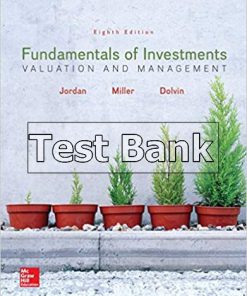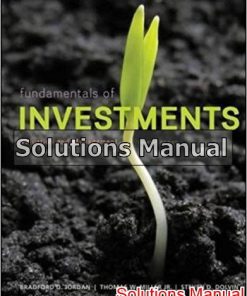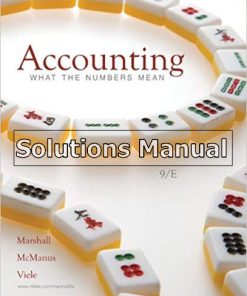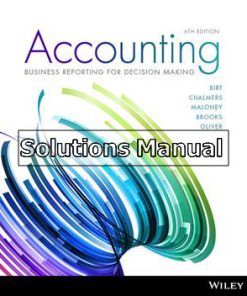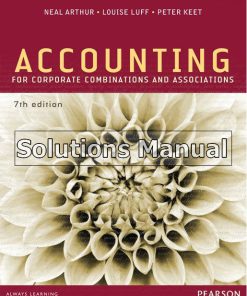Fundamentals of Investments 6th Edition Jordan Solutions Manual
$26.50$50.00 (-47%)
Fundamentals of Investments 6th Edition Jordan Solutions Manual.
You may also like
Fundamentals of Investments 6th Edition Jordan Solutions Manual
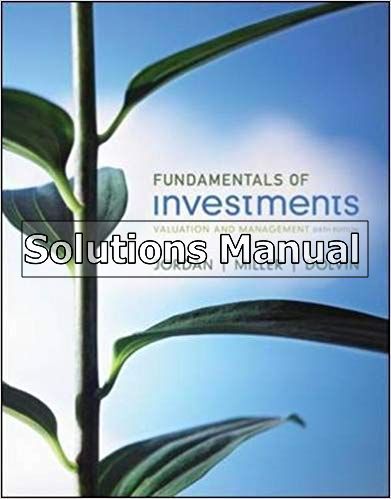
Product details:
- ISBN-10 : 0073530719
- ISBN-13 : 978-0073530710
- Author: Bradford D. Jordan
Fundamentals of Investments was written to: focus on students as investment managers, giving them information they can act on instead of concentrating on theories and research without the proper context; offer strong, consistent pedagogy, including a balanced, unified treatment of the main types of financial investments as mirrored in the investment world; and, organize topics in a way that makes them easy to apply – whether to a portfolio simulation or to real life – and support these topics with hands-on activities. The approach of this text reflects two central ideas. First, there is a consistent focus on the student as an individual investor or investments manager. Second, a consistent, unified treatment of the four basic types of financial instruments – stocks, bonds, options, and futures – focusing on their chara
Table contents:
Introduction to Investments 1 1 The Investment Setting 4 Forms of Investment 6 The Setting of Investment Objectives 7 Risk and Safety of Principal 7 Current Income versus Capital Appreciation 8 Liquidity Considerations 8 Short-Term versus Long-Term Orientation 9 Tax Factors 9 Ease of Management 10 Retirement and Estate Planning Considerations 11 Measures of Risk and Return 12 Risk 13 Actual Consideration of Required Returns 13 Real Rate of Return 14 Anticipated Inflation Factor 15 Risk Premium 15 What You Will Learn 19 Appendix 1A Career Opportunities in Investments 24 2 Security Markets: Present and Future 27 The Market Environment 28 Market Functions 29 Market Efficiency and Liquidity 29 Competition and Allocation of Capital 30 Secondary Markets 30 Primary Markets 30 Organization of the Primary Markets: The Investment Banker 30 Underwriting Function 31 Distribution 31 Investment Banking Competition 34 Organization of the Secondary Markets 37 Organized Exchanges 38 Consolidated Tape 39 Listing Requirements for Firms 39 Membership for Market Participants 41 Other Organized Exchanges 43 The American Stock Exchange 43 The Chicago Board Options Exchange 45 Futures Markets 45 Over-the-Counter Markets 46 Nasdaq 46 Debt Securities Traded Over-the-Counter 47 The Third and Fourth Markets: Part of Over-the-Counter Trading 48 Electronic Communication Networks 48 Institutional Trading 50 The National Market System and the Future 51 Regulation of the Security Markets 51 Securities Act of 1933 52 Securities Exchange Act of 1934 52 The Securities Acts Amendments of 1975 53 Other Legislation 53 Insider Trading 53 Program Trading and Market Price Limits 53 3 Participating in the Market 61 Measures of Price Performance: Market Indexes 62 Indexes and Averages 62 Dow Jones Averages 62 Standard and Poor?s Indexes 64 Value Line Average 66 Other Market Indexes 67 Buying and Selling in the Market 69 Cash or Margin Account 72 Long or Short??That Is the Question 73 Types of Orders 74 Cost of Trading 76 Taxes and the 2001 Tax Act 77 Capital Gains 78 4 Sources of Investment Information 88 Aggregate Economic Data 89 Federal Reserve Bulletin 89 2 chapter Federal Reserve Banks 90 Survey of Current Business 93 Websites and Economic Data 93 Other Sources of Economic Data 94 Investment Advisory Services 94 Moody?s 96 Standard & Poor?s 96 Value Line 99 Morningstar 101 Other Investment Services 103 ISEC Filings, Periodicals, and Journals 105 Securities and Exchange Commission Filings 105 Periodicals and Newspapers 106 Journals 112 Computer Databases 113 The Use of Personal Computers 114 The Internet and Investment Information 114 Additional Websites 115 part two Analysis and Valuation of Equity Securities 120 5 Economic Activity 122 Economic Activity and the Business Cycle 124 Federal Government Economic Policy 124 Fiscal Policy 126 Monetary Policy 129 Government Policy, Real Growth, and Inflation 129 Business Cycles and Cyclical Indicators 132 Economic Indicators 134 Money Supply and Stock Prices 137 Business Cycles and Industry Relationships 138 6 Industry Analysis 146 Industry Life Cycles 147 Development?Stage I 147 Growth?Stage II 148 Expansion?Stage III 149 Maturity?Stage IV 150 Decline?Stage V 151 Growth in Nongrowth Industries 153 Industry Structure 153 Economic Structure 154 Competitive Structure 155 Industry Trend Analysis 157 Industry Groups and Rotational Investing 161 Appendix 6A Sustainable Growth Model 167 7 Valuation of the Individual Firm 170 Basic Valuation Concepts 171 Review of Risk and Required Rate of Return Concepts 171 Dividend Valuation Models 172 General Dividend Model 173 Constant Growth Model 173 A Nonconstant Growth Model 175 Earnings Valuation Models 177 The Combined Earnings and Dividend Model 177 The Price-Earnings Ratio 180 The P/E Ratio for Individual Stocks 182 The Pure, Short-Term Earnings Model 183 Relating an Individual Stock?s P/E Ratio to the Market 184 Other Valuation Models Using Average Price Ratios and 10-Year Averages 185 Forecasting Earnings per Share 186 Least Squares Trendline 187 The Income Statement Method 189 Growth Stocks and Growth Companies 190 Assets as a Source of Stock Value 191 Natural Resources 191 8 Financial Statement Analysis 203 The Major Financial Statements 204 Income Statement 204 Balance Sheet 206 Statement of Cash Flows 208 Key Financial Ratios for the Security Analyst 211 Ratio Analysis 211 Bankruptcy Studies 212 Classification System 213 Uses of Ratios 220 3 chapter chapter 4 chapter chapter Comparing Long-Term Trends 223 Deficiencies of Financial Statements 226 Inflation Effects 226 Inventory Valuation 227 Extraordinary Gains and Losses 229 Pension Fund Liabilities 229 Foreign Exchange Transactions 229 Other Distortions 230 part three Issues in Efficient Markets 242 9 A Basic View of Technical Analysis and Market Efficiency 244 Technical Analysis 245 The Use of Charting 246 Essential Elements of the Dow Theory 246 Support and Resistance Levels 247 Volume 248 Types of Charts 249 Key Indicator Series 252 Contrary Opinion Rules 253 Smart Money Rules 256 Overall Market Rules 258 Efficient Market Hypothesis 259 Weak Form of the Efficient Market Hypothesis 261 Tests of Independence 261 Trading Rule Tests 261 Implications for Technical Analysis 262 Semistrong Form of the Efficient Market Hypothesis 262 Implications for Fundamental Analysis 262 Strong Form of the Efficient Market Hypothesis 265 10 Investments in Special Situations 271 Mergers and Acquisitions 272 Premiums for Acquired Company 272 Acquiring Company Performance 275 Form of Payment 275 Leveraged Buyouts 275 New Stock Issues 276 Performance of Investment Bankers 277 Factors to Consider in a New Issue 277 Exchange Listings 278 Stock Repurchase 280 Reasons for Repurchase 280 Actual Market Effect 280 The Small-Firm and Low-P/E-Ratio Effect 282 The Latest Theory?The Book Value to Market Value Effect 285 Other Stock-Related Special Situations 285 Truly Superior Returns or Mismeasurement? 288 part four Fixed-Income and Leveraged Securities 294 11 Bond and Fixed-Income Fundamentals 296 The Bond Contract 297 Secured and Unsecured Bonds 298 The Composition of the Bond Market 299 U.S. Government Securities 300 Federally Sponsored Credit Agency Issues 303 State and Local Government Securities 304 Corporate Securities 306 Bond Market Investors 308 Distribution Procedures 309 Private Placement 309 Bond Ratings 309 Actual Rating System 311 Junk Bonds 312 Bond Quotes 313 Bond Markets, Capital Market Theory, and Efficiency 318 The Global Bond Market 318 Dollar-Denominated Bonds 319 Foreign-Pay Bonds 319 Other Forms of Fixed-Income Securities 320 Preferred Stock as an Alternative to Debt 321 Features of Preferred Stock 322 12 Principles of Bond Valuation and Investment 331 Fundamentals of the Bond Valuation Process 332 Rates of Return 334 chapter chapter chapter 5 chapter Current Yield 334 Yield to Maturity 335 Yield to Call 336 Anticipated Realized Yield 339 Reinvestment Assumption 340 The Movement of Interest Rates 340 Term Structure of Interest Rates 341 Investment Strategy: Interest-Rate Considerations 344 Bond-Pricing Rules 346 Example of Interest-Rate Change 346 Deep Discount versus Par Bonds 347 Yield Spread Considerations 347 Bond Swaps 349 Appendix 12A Interpolating to Find Yield to Maturity 357 13 Duration and Reinvestment Concepts 358 Review of Basic Bond Valuation Concepts 359 Duration 360 Duration and Price Sensitivity 363 Duration and Market Rates 366 Duration and Coupon Rates 367 Bringing Together the Influences on Duration 368 Duration and Zero-Coupon Bonds 369 The Uses of Duration 370 Bond Reinvestment Assumptions and Terminal Wealth Analysis 371 Reinvestment Assumptions 371 Terminal Wealth Analysis 372 Zero-Coupon Bonds and Terminal Wealth 374 Appendix 13A Modified Duration and Convexity 381 14 Convertible Securities and Warrants 383 Convertible Securities 384 Conversion Price and Conversion Ratio 384 Value of the Conversion Bond 385 Bond Price and Premiums 386 After the Merger with Symbol Technologies 390 Comparing the Convertible Bond with Common Stock Purchase 391 Disadvantages of Convertibles 393 When to Convert into Common Stock 393 Advantages and Disadvantages to the Issuing Corporation 394 Accounting Considerations with Convertibles 396 Innovations in Convertible Securities 397 Speculating through Warrants 398 Valuation of Warrants 399 Further Explanation of Intrinsic Value 401 Use of Warrants by Corporations 402 Accounting Considerations with Warrants 402 part five Derivative Products 410 15 Put and Call Options 412 Options Markets 413 Listed Options Exchanges 413 The Options Clearing Corporation 416 Option Premiums 416 Intrinsic Value 418 Speculative Premium 418 Basic Option Strategies 421 Buying Call Options 423 Writing Call Options 425 Buying Put Options 427 Using Options in Combinations 428 Spreads 428 Straddles 428 Other Option Considerations 429 Appendix 15A The Black-Scholes Option Pricing Model 434 Appendix 15B The Use of Option Spreads and Straddles 441 16 Commodities and Financial Futures 445 Types of Commodities and Exchanges 447 Types of Commodities Contracts 449 xx Contents hir39632_fm.qxd 11/22/02 9:37 AM Page xx chapter 6 chapter chapter chapter Actual Commodities Contract 449 Margin Requirements 450 Market Conditions 450 Gains and Losses 450 Price Movement Limitations 452 Reading Market Quotes 452 The Cash Market and the Futures Market 454 The Futures Market for Financial Instruments 454 Currency Futures 455 Interest-Rate Futures 456 Hedging with Interest-Rate Futures 458 An Actual Example 459 Options as Well as Futures 460 Interest-Rate Swaps 460 17 Stock Index Futures and Options 469 The Concept of Derivative Products 470 Trading Stock Index Futures 471 Trading Cycle 472 Margin Requirement 473 Cash Settlement 473 Basis 474 Overall Features 475 Use of Stock Index Futures 475 Speculation 475 Hedging 477 Arbitraging 480 Trading Stock Index Options 481 Actual Trade in the S&P 100 Index 481 Hedging with Stock Index Options 483 Options on Stock Index Futures 484 part six Broadening the Investment Perspective 492 18 International Securities Markets 494 The World Equity Market 495 Diversification Benefits 501 Return Potential in International Markets 504 Current Quotations of Foreign Market Performance 506 Other Market Differences 507 Currency Fluctuations and Rates of Return 509 Other Obstacles to International Investments 511 Political Risks 511 Tax Problems 512 Lack of Market Efficiency 512 Administrative Problems 512 Information Difficulties 512 Methods of Participating in Foreign Investments 513 Direct Investments 513 Indirect Investments 516 19 Mutual Funds 525 Advantages and Disadvantages of Mutual Funds 527 Closed-End versus Open-End Funds 528 Exchange Traded Funds 530 Investing in Open-End Funds 530 Load versus No-Load Funds 531 No-Load Funds 531 Differing Objectives and the Diversity of Mutual Funds 537 Matching Investment Objectives with Fund Types 541 The Prospectus 542 Distribution and Taxation 543 Tax Differences between Mutual Funds and Individual Stock Portfolios 543 Shareholder Services 544 Investment Funds, Long-Term Planning, and Dollar-Cost Averaging 544 Evaluating Fund Performance 546 Lipper Mutual Fund Performance Averages 547 Computing Total Return on Your Investment 547 Appendix 19A Unit Investment Trusts (UITs) 555 20 Investments in Real Assets 557 Advantages and Disadvantages of Real Assets 558 Real Estate as an Investment 559 Real Estate in the Last Decade and the Future Outlook 559 Valuation of Real Estate 561 The Cost Approach 561 Comparative Sales Value 561 7 chapter chapter xxii Contents The Income Approach 562 Combination of the Three Approaches 562 A More Comprehensive Analysis 562 Financing of Real Estate 567 Types of Mortgages 568 Forms of Real Estate Ownership 569 Individual or Regular Partnership 569 Syndicate or Limited Partnership 570 Real Estate Investment Trust 571 Gold and Silver 572 Gold 572 Silver 575 Precious Gems 575 Other Collectibles 577 part seven Introduction to Portfolio Management 584 21 A Basic Look at Portfolio Management and Capital Market Theory 586 Formal Measurement of Risk 587 Expected Value 588 Standard Deviation 588 Portfolio Effect 590 Standard Deviation for a Two-Asset Portfolio 591 Developing an Efficient Portfolio 593 Risk-Return Indifference Curves 595 Optimum Portfolio 597 Capital Asset Pricing Model 597 Capital Market Line 600 Return on an Individual Security 601 Systematic and Unsystematic Risk 603 Security Market Line 604 Assumptions of the Capital Asset Pricing Model 606 Appendix 21A The Correlation Coefficient 613 Appendix 21B Least Squares Regression Analysis 614 Appendix 21C Derivation of the Security Market Line (SML) 615 Appendix 21D Arbitrage Pricing Theory 616 22 Measuring Risks and Returns of Portfolio Managers 620 Stated Objectives and Risk 621 Measurement of Return in Relation to Risk 622 Sharpe Approach 623 Treynor Approach 623 Jensen Approach 624 Adequacy of Performance 624 Diversification 628 Other Assets as Well as Stocks 630 A Specific Example?Asset Allocation 632 The Makeup of Institutional Investors 634 Investment Companies (Including Mutual Funds) 636 Other Institutional Investors 636 appendices Appendix A Compound Sum of $1 646 Appendix B Compound Sum of an Annuity of $1 648 Appendix C Present Value of $1 650 Appendix D Present Value of an Annuity of $1 652 Appendix E Time Value of Money and Investment Applications 654 Appendix F Using Calculators for Financial Analysis 663 glossary 672 index 690
People also search:
fundamentals of investments pdf
fundamentals of investment management 10th edition
fundamentals of investment management
the fundamentals of investing answer key
the fundamentals of investing answers

